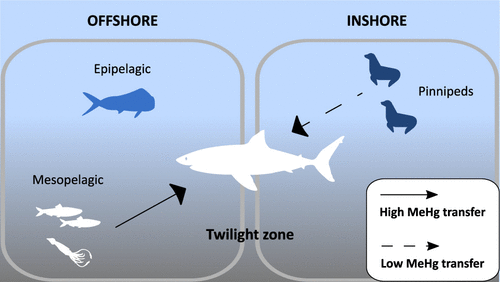当前位置:
X-MOL 学术
›
Environ. Sci. Technol.
›
论文详情
Our official English website, www.x-mol.net, welcomes your
feedback! (Note: you will need to create a separate account there.)
The Twilight Zone as a Major Foraging Habitat and Mercury Source for the Great White Shark
Environmental Science & Technology ( IF 10.8 ) Pub Date : 2020-11-25 , DOI: 10.1021/acs.est.0c05621 Gaël Le Croizier 1 , Anne Lorrain 2 , Jeroen E. Sonke 1 , E. Mauricio Hoyos-Padilla 3, 4 , Felipe Galván-Magaña 5 , Omar Santana-Morales 6 , Marc Aquino-Baleytó 3, 5 , Edgar E. Becerril-García 3, 5 , Gádor Muntaner-López 3, 5 , James Ketchum 3 , Barbara Block 7 , Aaron Carlisle 8 , Salvador J. Jorgensen 9 , Lucien Besnard 2 , Armelle Jung 10 , Gauthier Schaal 2 , David Point 1
Environmental Science & Technology ( IF 10.8 ) Pub Date : 2020-11-25 , DOI: 10.1021/acs.est.0c05621 Gaël Le Croizier 1 , Anne Lorrain 2 , Jeroen E. Sonke 1 , E. Mauricio Hoyos-Padilla 3, 4 , Felipe Galván-Magaña 5 , Omar Santana-Morales 6 , Marc Aquino-Baleytó 3, 5 , Edgar E. Becerril-García 3, 5 , Gádor Muntaner-López 3, 5 , James Ketchum 3 , Barbara Block 7 , Aaron Carlisle 8 , Salvador J. Jorgensen 9 , Lucien Besnard 2 , Armelle Jung 10 , Gauthier Schaal 2 , David Point 1
Affiliation

|
The twilight zone contains the largest biomass of the world’s ocean. Identifying its role in the trophic supply and contaminant exposure of marine megafauna constitutes a critical challenge in the context of global change. The white shark (Carcharodon carcharias) is a threatened species with some of the highest concentrations of neurotoxin methylmercury (MeHg) among marine top predators. Large white sharks migrate seasonally from coastal habitats, where they primarily forage on pinnipeds, to oceanic offshore habitats. Tagging studies suggest that while offshore, white sharks may forage at depth on mesopelagic species, yet no biochemical evidence exists. Here, we used mercury isotopic composition to assess the dietary origin of MeHg contamination in white sharks from the Northeast Pacific Ocean. We estimated that a minimum of 72% of the MeHg accumulated by white sharks originates from the consumption of mesopelagic prey, while a maximum of 25% derives from pinnipeds. In addition to highlighting the potential of mercury isotopes to decipher the complex ecological cycle of marine predators, our study provides evidence that the twilight zone constitutes a crucial foraging habitat for these large predators, which had been suspected for over a decade. Climate change is predicted to expand the production of mesopelagic MeHg and modify the mesopelagic biomass globally. Considering the pivotal role of the twilight zone is therefore essential to better predict both MeHg exposure and trophic supply to white sharks, and effectively protect these key vulnerable predators.
中文翻译:

暮光区是大白鲨的主要觅食栖息地和汞源
暮光区包含世界上最大的生物量。在全球变化的背景下,确定其在海洋大型动物的营养供应和污染物暴露中的作用是一项严峻的挑战。白鲨(Carcharodon carcharias)是海洋顶级捕食者中神经毒素甲基汞(MeHg)浓度最高的一种受威胁物种。大白鲨有季节性地从沿海栖息地(主要在尖刺中觅食)迁移到海洋近海栖息地。标签研究表明,在近海时,白鲨可能会在中生远缘物种的深处觅食,但尚无生化证据。在这里,我们使用汞同位素组成来评估东北太平洋白鲨中MeHg污染的饮食来源。我们估计,白鲨积累的MeHg至少有72%来自食用近中生猎物,而最多的25%来自from鱼。除了强调汞同位素可能破译海洋捕食者复杂的生态循环外,我们的研究提供的证据表明,对于这些大型掠食者而言,暮光带是其重要的觅食栖息地,而这些捕食者已经被怀疑了十多年。预计气候变化将扩大中弹性MeHg的生产并在全球范围内改变中弹性生物量。因此,考虑到暮光区的关键作用对于更好地预测甲基汞的暴露量和白鲨的营养供应,并有效地保护这些脆弱的捕食者至关重要。
更新日期:2020-12-15
中文翻译:

暮光区是大白鲨的主要觅食栖息地和汞源
暮光区包含世界上最大的生物量。在全球变化的背景下,确定其在海洋大型动物的营养供应和污染物暴露中的作用是一项严峻的挑战。白鲨(Carcharodon carcharias)是海洋顶级捕食者中神经毒素甲基汞(MeHg)浓度最高的一种受威胁物种。大白鲨有季节性地从沿海栖息地(主要在尖刺中觅食)迁移到海洋近海栖息地。标签研究表明,在近海时,白鲨可能会在中生远缘物种的深处觅食,但尚无生化证据。在这里,我们使用汞同位素组成来评估东北太平洋白鲨中MeHg污染的饮食来源。我们估计,白鲨积累的MeHg至少有72%来自食用近中生猎物,而最多的25%来自from鱼。除了强调汞同位素可能破译海洋捕食者复杂的生态循环外,我们的研究提供的证据表明,对于这些大型掠食者而言,暮光带是其重要的觅食栖息地,而这些捕食者已经被怀疑了十多年。预计气候变化将扩大中弹性MeHg的生产并在全球范围内改变中弹性生物量。因此,考虑到暮光区的关键作用对于更好地预测甲基汞的暴露量和白鲨的营养供应,并有效地保护这些脆弱的捕食者至关重要。











































 京公网安备 11010802027423号
京公网安备 11010802027423号